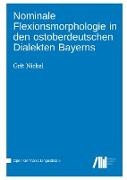Share
Fr. 66.00
Grit Nickel
Nominale Flexionsmorphologie in den ostoberdeutschen Dialekten Bayerns
English · Hardback
Shipping usually within 2 to 3 weeks (title will be printed to order)
Description
Diese Arbeit fokussiert die nominale Flexionsmorphologie der ostoberdeutschen Dialekte in ihrer Systematik. Dialekte sind insbesondere für Fragen zum morphologischen Wandel relevant, da sie im Vergleich zum Standard gesprochensprachlichen Wandel besser repräsentieren. Gleichzeitig weisen Dialekte spezifischen Wandel in Phonologie und an der Schnittstelle von Phonologie und Morphologie auf. Die kontrastive Studie dialektaler Flexionsverfahren unter varianten phonologischen Voraussetzungen kann hier zeigen, wo die formale Varianz phonologisch bedingt ist, wo sie das Ergebnis genuin morphologischer Prozesse ist und wo beide Ebenen interagieren. Damit verbindet die Studie die synchrone, diachrone und areale Perspektive.Mit dem Ziel, die Spezifika und Gemeinsamkeiten der nominalen Numerus- und Kasusflexion für die drei Teilräume des Ostoberdeutschen (Ostfränkisch, Nord- und Mittelbairisch) in ihrer Systematik kontrastiv darzustellen, wurde für 37 Ortsdialekte und die syntaktische Einheit aus Definitartikel und Substantiv Datenmaterial des Forschungsprojekts Bayerischer Sprachatlas ausgewertet. Der erste Teil der Datenauswertung fokussiert die Formenbildung des Substantivs, wobei das Ziel der Untersuchung nicht nur in einer Inventarisierung der einzelnen (evtl. dialektraumspezifischen) Markierungsstrategien für Numerus und Kasus besteht, sondern in der Erfassung des Systems. Im Zentrum des zweiten Teils stehen die Struktur der dialektalen Deklinationsklassensysteme und die Frage, inwiefern Deklinationsklassen diachron und synchron zu außerflexivischer Konditionierung tendieren (z.B. durch semantische oder phonotaktisch-prosodische Faktoren). Der dritte Teil der Datenauswertung behandelt schließlich den morphosyntaktischen Kontext und die Frage, wo Numerus und Kasus in der Nominalphrase markiert werden und inwiefern die Markierung durch morphologische oder syntaktische Mittel oder durch Disambiguierung im semantisch-pragmatischen Kontext erfolgt. Abschließend erfolgt eine Diskussion der Ergebnisse vor dem Hintergrund von Grammatikmodellen, die morphologischen Wandel, Sprachgebrauch und Kognition fokussieren. This book comprises a systematic analysis of the nominal inflectional systems of 37 local dialects of the East Upper German variety (i.e., East Franconian, North and Central Bavarian), analyzing data drawn from the research project Bavarian Linguistic Atlas (Bayerischer Sprachatlas). The surveyed dialects show a wide spectrum of variation with regard to dialect-specific phonological change and subsequently exhibit variation at the interface of phonology and morphology, making a contrastive study of dialect morphology worthwhile. The first part of the data analysis focuses on number and case marking strategies, surveying the local dialects¿ allomorphs from a synchronic and diachronic perspective. The second part addresses the structure of dialect declension classes, specifically focusing on superior assignment principles. In a third step, noun phrases are included into the analysis, widening the focus to the more general question of whether the coding of plural (or case) information is necessarily attributed to inflectional morphology, or whether plural (or case) coding has to be located at the interface between morphology, syntax and context. Finally, the data analysis is followed by a discussion, covering theoretical (namely usage-based) approaches on morphological change
About the author
Grit Nickel schloss ihre Promotion in Deutscher Sprachwissenschaft 2021 an der Katholischen Universität Eichstätt-Ingolstadt ab. Für ihre Dissertation erhielt sie 2022 den Nachwuchspreis der Internationalen Gesellschaft für Dialektologie des Deutschen e.V. (IGDD). Derzeit ist sie im Bereich Wissenschaftskommunikation tätig. Ihre Forschungsschwerpunkte sind die nominale Flexionsmorphologie der ostoberdeutschen Dialekte, Morphophonologie, Morphosyntax und sprachliche Variabilität.
Grit Nickel received her Ph.D. in German Linguistics in 2021 from the Catholic University of Eichstätt-Ingolstadt and is currently working in science communication. Her research interests include dialect inflection morphology, morphophonology, morphosyntax, and linguistic variation.
Product details
| Authors | Grit Nickel |
| Publisher | Language Science Press |
| Languages | English |
| Product format | Hardback |
| Released | 13.11.2023 |
| EAN | 9783985540723 |
| ISBN | 978-3-98554-072-3 |
| No. of pages | 380 |
| Dimensions | 175 mm x 246 mm x 29 mm |
| Weight | 900 g |
| Series |
Open Germanic Linguistics 6 |
| Subject |
Humanities, art, music
> Linguistics and literary studies
> Other languages / Other literatures
|
Customer reviews
No reviews have been written for this item yet. Write the first review and be helpful to other users when they decide on a purchase.
Write a review
Thumbs up or thumbs down? Write your own review.

